Street Maintenance Procedure
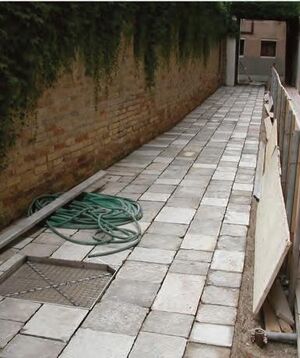
Venice's ancient walk ways and historical Masegni stones hold an invaluable amount of cultural and historical value. It is for this reason that the restoration process of Venice's Streets has a very tedious and methodical procedure to ensure that the heritage is sustained during the maintenance process. The restoration process created by Insula has 8 steps that must be followed rigorously by contracted companies taking on restoration work. After the restoration has been done all data regarding the project is compiled into an in depth stone registration report. This report includes the registration of every stone present on the street, all stones reused, discarded as well as a project overview.
Census
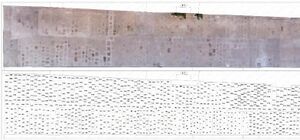
The first step in the restoration process takes place in Insula offices, before contracting the work, or even receiving the necessary grants to perform the restoration. An aerial picture is taken and an exact blue print type diagram is generated. This diagram has the exact measurement and shape of each stone present on the street in intervention. Each Masegno stone is then given a registration number. The stones numbers are by Corso number and Masegno number in that Corso (ex. 3-14 is Corso 3 Stone 14). After this in depth census is done and the grant is received the physical work can begin. As of late a more summarized census has been adopted so as not to waste time and resources if a grant is denied.
Numbering and Scarifying of Joints
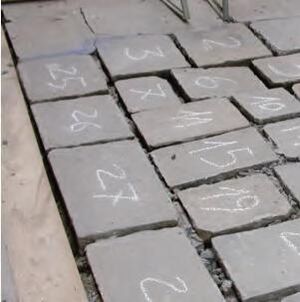
The second step in the process is to number each individual Masegno. To do this workers physically mark each stone with its predesignated registration number using a chalk like marker. After numbering the stones the Street Joints are cleared of cement or mud (to see more about pavement joints see Street).
Measurements
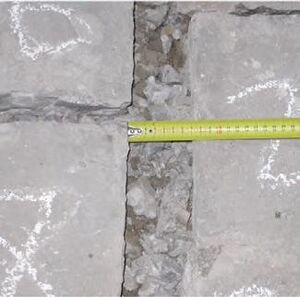
Each Masegnostones distance from the end of the Street is measured and recorded in order to have the exact location of the stone. By taking measurements of the stones distances the work crew can also tell how big the fuga or "gaps" in between each stone is. If the joint exceeds the Measurement Restriction a stone will have to be replaced. In addition to this inspection the area of stones that cover the street area versus the area covered by gaps is calculated and recorded. On average each street is composed of 90% stones and 10% gaps.[1]
Removal of Masegni
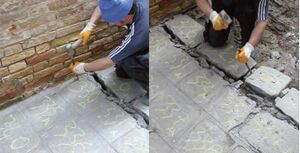
Each Masegno contains irreplaceable historic value to Venice and therefore are removed one at a time by skillful hand so as not to damage them. The mortar is loosed by using a chisel and the stones are removed numerically and placed in order on pallets.
Packaging and Storing
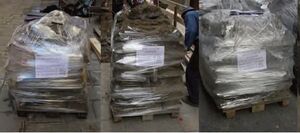
Each pallet is filled with stones and given a number. Every pallets number of stones and which numbered stones are recorded. The pallets are then wrapped up in order to protect and transport the stones from the project site to the contracted companies site. Each pallet also receives a seal of proof for verification.[2]
Stone Inspection
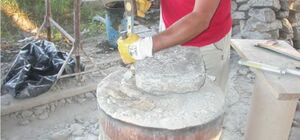
The pallets filled with the Masegni are transported to a delegated area in order to clean and inspect the stones. Each stone is cleaned of any remaining Malta cement and inspected to determine whether they're still usable. Since these ancient stones are so valuable they are reused as much as possible and only discarded for one of four reasons. Firstly if the stone has imperfections such as cracks or chips that jeopardize the structural integrety of the stone it is discarded. Another reason why a stone may be discarded is if it served as a Caditoia and therefore has drain holes. A stone will also not be reused if it has a metal cap installed. Lastly the size of the stones are determined using a Venetian tool coined a Dima. If it is determined that the stone is too small it is discarded. Because traditional Masegni are so valuable the size restrictions on these stones is more flexible than new Masegni. If for any reason a stone is discarded it must be recorded and the reason why given. On average 1 out of every 3 stones is not reusable.[3]
Packaging and Disposal
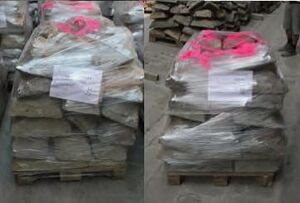
Stones that are deemed unusable are placed on special pallets marked with pink spray paint while usable stones are returned in order to their original pallets to be transported back to the restoration project.[4]
Posa
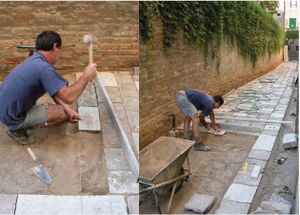
After the Masegni are cleaned and transported back to the Street they are laid down one at a time by skillful hand of a dry bed of sabbiacemento. Pallet by pallet the stones are laid down in ordered and as much as possible in their exact original location.
Mortar and Bocciardatura
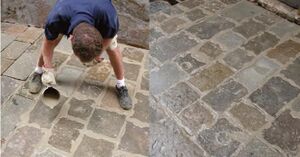
Lastly, after all the stones have been carefully laid down and the Streets appearance is compared to the original for any flagrant differences, the joints are poured and the Venetian technique of boiccatura is performed. Depending on the stones used and the pavement layout the joints can be either Malta cement or mud. (For more information about joint types see Street). The technique known as boiccatura is to add a specific look to the Masegni. In traditional Masegni a hammer was used to hit the top surface of the stone to create this look. Now machines are used either as soon as the stones are quarried or before laying down the stones.[5]
Registration Report
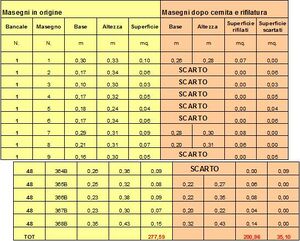
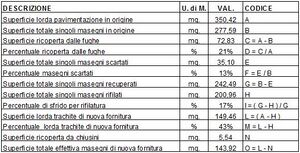
After the restoration process is completed a registration report is compiled of the project. The report is composed of an in depth analysis of every stone present on the Street as well as whether they were reused or discarded. Graphs and tables are generated from all this information in order to have a detailed registration of each Masegni.[6]
See Also
References
- ↑ Ing. Lorenzo Bottazzo, Nov 2011
- ↑ The "Masegne" of Venice. Methodology of intervention in the pavement history of Venice., Insula spa.
- ↑ The "Masegne" of Venice. Methodology of intervention in the pavement history of Venice., Insula spa.
- ↑ The "Masegne" of Venice. Methodology of intervention in the pavement history of Venice., Insula spa.
- ↑ The "Masegne" of Venice. Methodology of intervention in the pavement history of Venice., Insula spa.
- ↑ Ing. Lorenzo Bottazzo, Nov 2011